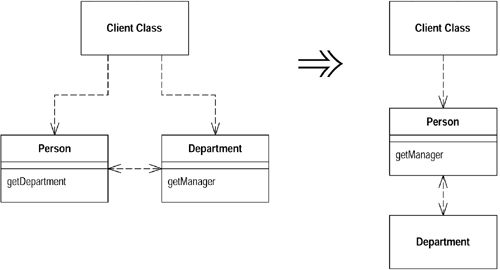Hide Delegate
From CSSEMediaWiki
(Difference between revisions)
(New page: A client is calling a delegate class of an object. Create methods on the server to hide the delegate. image:hideDelagate.gif <br> One of the keys, if not the key, to objects is encaps...) |
JaninaVoigt (Talk | contribs) |
||
| Line 2: | Line 2: | ||
[[image:hideDelagate.gif ]]<br> | [[image:hideDelagate.gif ]]<br> | ||
| − | One of the keys, if not the key, to objects is encapsulation. Encapsulation means that objects need to know less about other parts of the system. Then when things change, fewer objects need to be told about the change—which makes the change easier to make. | + | |
| + | One of the keys, if not the key, to objects is encapsulation. Encapsulation means that objects need to know less about other parts of the system. Then when things change, fewer objects need to be told about the change—which makes the change easier to make. Essentially, we have decoupled the Client Class from the Department class so that it will not be affected by changes to the department. | ||
| + | |||
== Additional Resources == | == Additional Resources == | ||
[http://sourcemaking.com/refactoring/hide-delegate SourceMaking.com] | [http://sourcemaking.com/refactoring/hide-delegate SourceMaking.com] | ||
Revision as of 05:31, 28 August 2009
A client is calling a delegate class of an object. Create methods on the server to hide the delegate.
One of the keys, if not the key, to objects is encapsulation. Encapsulation means that objects need to know less about other parts of the system. Then when things change, fewer objects need to be told about the change—which makes the change easier to make. Essentially, we have decoupled the Client Class from the Department class so that it will not be affected by changes to the department.
